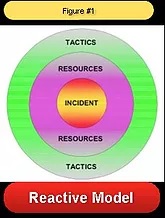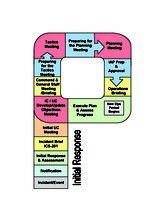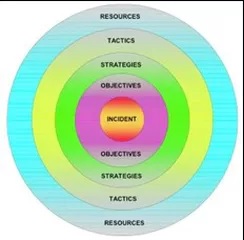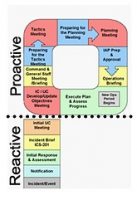“KA-BOOM!” happens and we launch our response. It is the ingrained nature of responders; when something happens, we react and respond to it. If set up for success and the response starts right, this initial reactionary response will lay the ground work for the next several operational periods, should the incident extend that long. If the response is not set up correctly from the beginning, it can make things more difficult in the long run, especially if the incident expands. Response transitioning can be compared to a game of chess, with a beginning game, a middle game, and an end game. How each part is played sets up the next.
Even though incident response is not a game, breaking it down into various phases can help you understand what needs to be done during each part. As in chess, how you start a response dictates how events move forward. The decisions made by the initial Incident Commander and Operations Section Chief are integral to how the rest of the team comes together to manage and mitigate the incident.

The initial incident response is often referred to as the reactive phase of the response as we are reacting to the incident and doing what we are trained to do, following our standard operating procedures and guidelines, and dealing with the situation as it comes at us. While this may work for the short term, this isn’t the most efficient way of conducting long term operations. In the reactive phase we are simply throwing resources at the problem, and the capabilities of the resources on hand limit the tactics we can employ (Figure 1). We need to quickly get out of this reactive phase and into a proactive one, where we identify and order the right resource for the task at hand.
 As part of our shift to a more proactive response, we can use the Incident Command System’s Operational Planning “P” as a guide to our transition process. Transitioning out of the reactive phase as we leave the stem of the “P”, we complete the first lap around the “P” and implement an Incident Action Plan (IAP). From that point forward, we are in the proactive phase, reacting only to sudden changes. Leaning forward and planning the way ahead is a much more efficient use of our time and resources.
As part of our shift to a more proactive response, we can use the Incident Command System’s Operational Planning “P” as a guide to our transition process. Transitioning out of the reactive phase as we leave the stem of the “P”, we complete the first lap around the “P” and implement an Incident Action Plan (IAP). From that point forward, we are in the proactive phase, reacting only to sudden changes. Leaning forward and planning the way ahead is a much more efficient use of our time and resources.
How long it takes to transition and work through this process will depend on several factors, including:
- Incident complexity
- External influences
- Availability of operational resources and overhead (management) resources
 Deciding to transition into the planning process too early can result in a poorly written Incident Action Plan (IAP) and may hinder safe and efficient operations. By creating a gap between the stem and the circle part of the “P”, we allow a pause in the operational planning process. This pause is a critical step in the transition process. Jumping to the next part of the process because the box is there and the team isn’t ready happens all too often, but is not the preferred way to move forward. The move into the stem is a conscious decision that has to be made by Command. To aid in making this decision, the Command needs to answer a few questions:
Deciding to transition into the planning process too early can result in a poorly written Incident Action Plan (IAP) and may hinder safe and efficient operations. By creating a gap between the stem and the circle part of the “P”, we allow a pause in the operational planning process. This pause is a critical step in the transition process. Jumping to the next part of the process because the box is there and the team isn’t ready happens all too often, but is not the preferred way to move forward. The move into the stem is a conscious decision that has to be made by Command. To aid in making this decision, the Command needs to answer a few questions:
- Is the incident stable enough to move into this process?
- As an Incident Management Team, are we ready to move into this process?
- Do we have a handle on our resource status and situation status?
- Is the Incident Management Team adequately staffed and equipped to move into this process?
Once command answers these questions and the team is ready, they can move forward into the operational planning process. But if the team determines they are not ready to move forward, they should not force the process. Instead, the team can continue to manage the incident using the ICS-201 and take the necessary steps to prepare to move into the proactive phase at a later time.
One of the founding principles of ICS is “management by objectives.” Objectives are statements of direction outlining what Command wants to accomplish. Objectives are established by Command while the steps necessary to accomplish the objectives are carried out by the Command and General Staff. Thinking about what needs to be accomplished and establishing objectives is a critical step in transitioning from the reactive to the proactive phase.
Writing objectives is a bit of an art form. Objectives should be achievable, measurable, and flexible. Objectives need to be specific enough so the staff knows what needs to be accomplished, but not overly prescriptive in that it limits the options and strategies available to accomplish the objective. In almost all cases, the objective statement begins with a verb. Objectives are more than simply a “to-do” list and should not be confused with staff assignments.
Once the objectives are written and briefed (usually at the Command and General Staff meeting), the Operations Section Chief (OSC) and Planning Section Chief (PSC) will scrutinize the objectives and divide the objectives into either operational objectives (handled by the OSC), or management objectives (usually handled by another member of the Command and General Staff). The operational objectives are further broken down into strategies.
Strategies outline “how” we are going to accomplish the objective. After listing various strategies, we look to choose the most appropriate one after considering policies, safety, resource availability, limitation/constraints, etc. The OSC will then further drill down the strategies into tactics. The tactics are where the “who, what, where” aspects of how we are going to accomplish the objective get assigned. The ICS-234 (Work Analysis Matrix) is an excellent tool to facilitate this process. Once we have the right strategy and the right tactic, we look at getting the right resource to accomplish the task. Now, we are in a proactive model of response.

Notice in the reactive model (Figure 1) how the layer right after the incident has resources, but in the proactive model, the resources are the last item of consideration. This ensures using the correct resource for the task at hand. We are no longer reacting and blindly throwing resources at the problem in hopes it will go away. We are deliberately and thoughtfully assigning the correct resources to carry out the desired tactics and strategies to accomplish the objective. This is the more efficient way of conducting a response.
Transitioning from reactive to proactive isn’t something that just happens; it takes time and effort to get there. Once you are in the proactive model, you are forecasting events and reacting only minimally to changes as they occur. This should be the goal of all long term responses. The old saying of “work smarter, not harder,” applies here. Use the Operational Planning “P” as a guide and tool to help transition the response out of the reactive model, but remember, transitioning the response is a considerable undertaking and should only be taken after careful consideration by Command.
To learn more about the author, Randy Ashmore, click here!


